- There are no more items in your cart
- Shipping Calculated at checkout
- Sub-Total (inc. VAT) £0.00
Need Help?
Fire Retardant Paints
Fire retardant paints are most frequently used in large scale industrial spaces, public buildings and facilities, or on new builds. They can also be used on smaller DIY projects, but not for those tasks that simply require heat resistant paint, like BBQs and exhaust pipes. Certain substrates and surfaces will require specialist fireproofing coatings, such as varnishes or intumescent paint. Click here for more info.
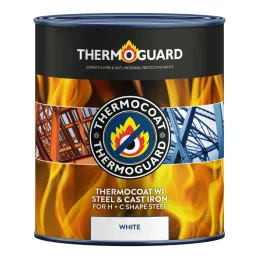
Thermoguard Thermocoat WI Ultimate
Interior use, water-based intumescent paint system, providing up to 90 mins fire resistance to structural steel and cast iron with a minimum number of coats. Optimised for Universal Beams, Columns and other open section steel:See Thermoguard Thermocoat WO Ultimate for steel hollow sections:For protection to exterior environment...
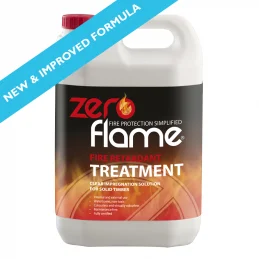
Zeroflame Fire Retardant Treatment
For use on bare, solid wood with a minimum thickness greater than 12mm.Soaks virtually ‘invisibly’ into the wood. Achieves Euroclass B s2 d0 (replaces UK Classes ‘0’ and ‘1’ BS 476 Part 6/7*). Can be overcoated for decorative purposes with waterborne, non-flammable stains, varnishes and paints. For internal and external use. Simple...
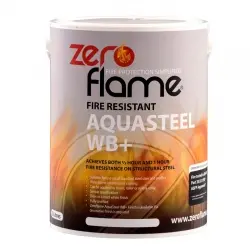
Zeroflame Aquasteel WB+
White thin-film waterbourne intumescent coating with new and improved formula to provide 30 and 60 minutes fire resistance on standard structural steel members in internal environments. It provides an easier and more efficient alternative to cladding steel members in plasterboard.New improved formula Achieves both 1/2 hour and 1 hour fire...
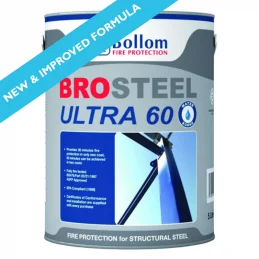
Bollom Brosteel Ultra 60
A new and improved revolutionary thin-film waterborne white intumescent paint for standard, interior structural steel members, providing 30 minutes fire protection in only one coat and 60 minutes in two coats - see below for details. For internal use only Water-based - quick drying thin-film intumescent coating Certificate of Conformance...
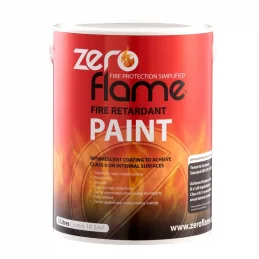
Zeroflame Fire Retardant Paint
A matt white, single-pack waterborne coating for wood that reduces ignitability for interior surfaces.Achieves Euroclass B s2 d0 (replaces UK Classes ‘0’ and ‘1’ BS 476 Part 6/7*). Can be overcoated with waterborne, non-flammable paints. Simple certificate application following purchase and application. Internal use. Can be applied by...
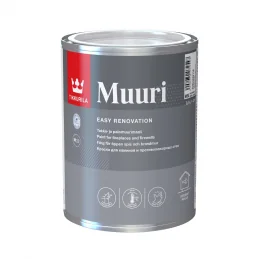
Tikkurila Fireplace Paint
9 colours. For fireplaces, firewalls, interior wall surfaces exposed to higher-than-normal temperatures. Concrete, brick, lime, lime cement, cement plaster, sandlime brick as well as mineral board surfaces. Also ideal for surfaces previously painted with lime, lime cement, cement & silicate paints. No primer required. Resistant to...
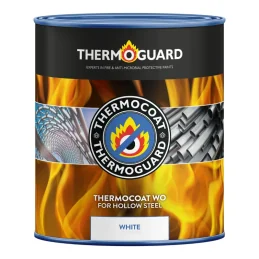
Thermoguard Thermocoat WO Ultimate
Water-based intumescent paint system providing fire resistance to structural steel and cast iron with a minimum number of coats. A compatible decorative overcoat system ensures the system will enhance the building’s architectural and design features.Optimised for CHS, SHS and RHS hollow sectionsSee Thermoguard Thermocoat WI Ultimate...
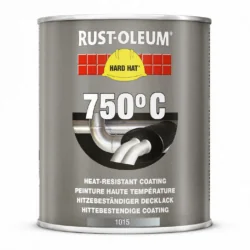
Rust-Oleum Heat Resistant Paint
Black and aluminium. For BBQs and barbecue grills, fireplace equipment, space heaters, boiler fittings, hot air cannons, exhausts, engines, heat cannons, pipes, vents, etc. Self-priming. For continuous temperatures up to 650°C. For peak temperatures up to 750°C. For bare metal or slightly rusted surfaces.Important!Self-priming -...
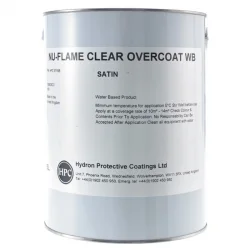
Hydron Nu-Flame Clear Overcoat
A clear varnish finish coating with flame retardant qualities. Protects the Nu-Flame Clear Impregnation when subjected to abrasion humidity, heat and general wear and tear.Tested to BS476 Part 7 Class 1 surface spread of flame and BS476 Part 6 Fire propagation. Designated Class '0' to current Building Regulations when used in conjunction...
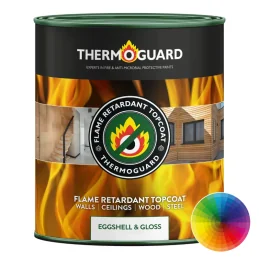
Thermoguard Flame Retardant Topcoat
An oil based, decorative flame-retardant paint with 4,000+ colours used to decorate and complete Thermoguard fire protection upgrading systems.BS476 Part 7; Class 1 surface spread to flame. BS476 Part 6; Fire propagation. Designated Class 0 in accordance with U.K. Building Regulations. Metallic colours (steel, gunmetal) available in...
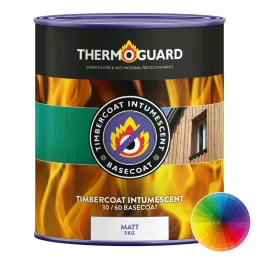
Thermoguard Timbercoat
An intumescent basecoat used as part 1 of a system to achieve 30 or 60 minute fire resistance for compartmentation.Can achieve 30 or 60 minutes Fire Resistance in certain instances subject to a specification from the Technical Department. For BS Class 1/0 and EN Class B only see Thermoguard Timbercoat Insulating Basecoat. Interior and...
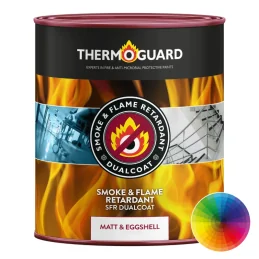
Thermoguard Smoke & Flame Retardant Dualcoat
4,000+ matt and eggshell colours for use over Thermoguard Timbercoat or Thermoguard Timbercoat Insulating Basecoat.Topcoat and maintenance paint for timber surfaces protected with Thermoguard Timbercoat. Emits a safe fire-damping vapour in a fire to control flame spread and suppress smoke. As part of a complete system achieves 30 or 60...
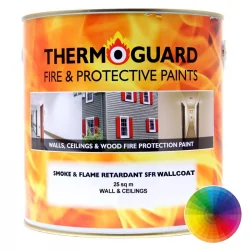
Thermoguard Wallcoat Smoke & Flame Retardant Topcoat
Fire-retardant paint in 4,000+ colours for walls and ceilings. Works in combination with Thermoguard Wallcoat Insulating Basecoat.Fire Certificate available on request Controls surface spread of flame and fire propagation Interior & exterior use Controls smoke and flaming droplets/particulates to BS EN Class B s1 d0 (as part of a...
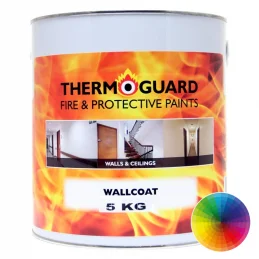
Thermoguard Wallcoat
Intumescent basecoat in 4,000 colours for overcoating with Thermoguard Wallcoat Smoke and Flame Retardant Topcoat to upgrade potentially dangerous 'multi-layer' - previously painted - walls and ceilings in communal areas to 30 or 60 minutes protection.Achieves EU and new British safety standards on walls and ceilings For painted plaster,...
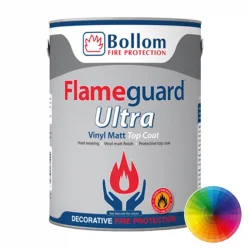
Bollom Flameguard Ultra Vinyl Matt
Top coat in 4,400+ matt colours for Bollom Broflame Ultra Basecoat on bare and previously painted wood and Bollom Brosteel Ultra 60.Provides Class 0 on non-combustible surfaces.Please note: Colours are sold in the nearest tin size but actual paint volume per tin may vary up to 10% depending on colour.Buy A Paint Colour Sample...
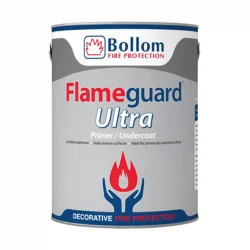
Bollom Flameguard Ultra Primer / Undercoat
A primer/undercoat for application prior to the use of Bollom Flameguard Ultra Topcoats on bare and previously painted non-combustible surfaces.Excellent adhesion Seals porous surfaces
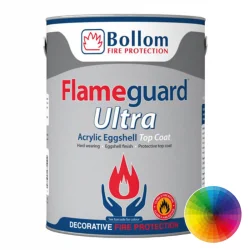
Bollom Flameguard Ultra Acrylic Eggshell
Top coat in 4,400+ eggshell colours for Bollom Broflame Ultra Basecoat on bare and previously painted wood, and Bollom Brosteel Ultra 60 for steel.Provides Class 0 on non-combustible surfaces.Please note: Colours are sold in the nearest tin size but actual paint volume per tin may vary up to 10% depending on colour.Buy A Paint...
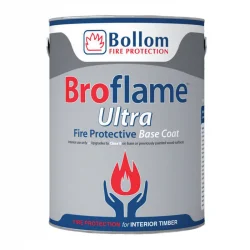
Bollom Broflame Ultra Basecoat
Decorative, thin film intumescent base coat that delivers a Class 0 rating over solid timber and particle boards when used in conjunction with Bollom Flameguard Ultra Topcoats.Achieves Class 0 fire protection rating to BS476: Parts 6 and 7 Hard wearing protective/decorative finish Water-based For all types of timber in communal areas
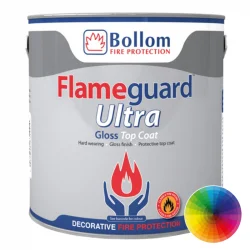
Bollom Flameguard Ultra Gloss
Top coat in 4,400+ gloss for Bollom Broflame Ultra Basecoat on bare and previously painted wood, also Bollom Brosteel Ultra 60 for steel.Provides Class 0 on non-combustible surfacesPlease note: Colours are sold in the nearest tin size but actual paint volume per tin may vary up to 10% depending on colour.Buy A Paint Colour Sample...
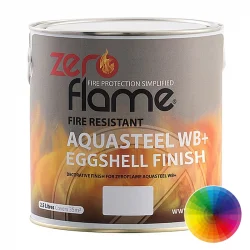
Zeroflame Aquasteel WB+ Finish
A hard-wearing flame-retardant topcoat with 4,400+ colours for application over Zeroflame Aquasteel WB+ Intumescent Coating:Class 0 fire rated finish on bare or previously painted non-combustible surfaces Hard wearing, water-based acrylic eggshell, matt or solvent-based gloss finish High coverage ratesImportant!Should be used in...
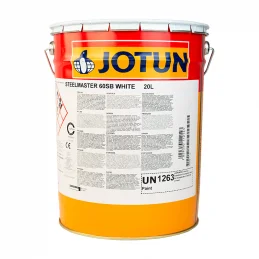
Jotun Steelmaster 60SB
One component solvent based acrylic thin film intumescent coating independently approved for fire protection of structural steel exposed to cellulosic fire. It can be used as a mid coat or finish coat in atmospheric environments and is suitable on approved primers on carbon steel and galvanised steel substrates.Specially designed as a...
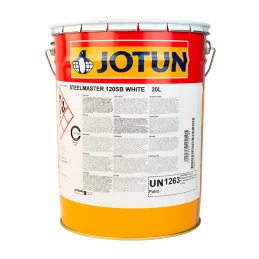
Jotun Steelmaster 120SB
Jotun Steelmaster 120SB is a one component solvent based acrylic thin film intumescent coating independently approved for fire protection of structural steel exposed to celulosic fire up to 120 minutes. It can be used as mid coat or finish coat in atmospheric environments and is suitable on approved primers on carbon steel and galvanised steel...
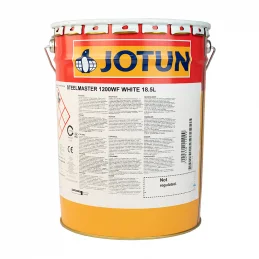
Jotun Steelmaster 1200WF
One component waterborne acrylic thin film intumescent coating independently tested and approved for fire protection of structural steel exposed to cellulosic fire up to 180 minutes. Suitable for properly prepared carbon steel substrates. Please Note: We strongly recommend Tricomb Plastic Wet Film Gauges are used to help ensure correct film...
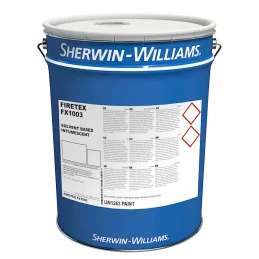
Sherwin-Williams Firetex FX1003
Single pack, thin film intumescent coating, designed for site application by airless spray, to provide fire resistance for up to 120 minutes on structural steel. Certificate Application
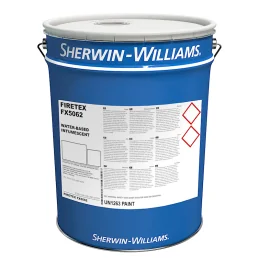
Sherwin-Williams Firetex FX5062
Water-based one-pack TCEP free thin film intumescent coating, specifically designed for airless spray application to provide fire resistance for periods up to 90 mins on structural steel. Firetex FX5062 has been Certifire Approved. Note: application schedule required before using - click to see more information below. Certificate Application...
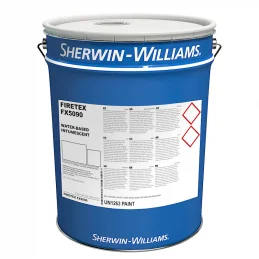
Sherwin-Williams Firetex FX5090
Water based TCEP free thin film intumescent coating, designed for application by airless spray to provide fire resistance for periods of up to 120 minutes on structural steel. Certificate Application
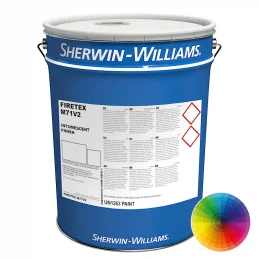
Sherwin-Williams Firetex M71V2
A sheen decorative topcoat in 450+ colours for the Firetex range of single pack intumescent coatings and also provides protection when used in internal semi-controlled conditions where condensation may occur (Category C2 as defined in ISO 12944-2).Please note: Also available in Ready Mixed Aluminium subject to an extended lead time of 28...
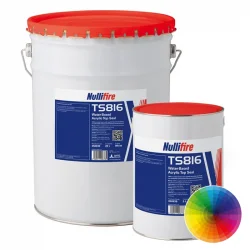
Nullifire TS816 Water-Based Acrylic Top Seal
A waterborne, acrylic eggshell decorative topseal in 4,300+colours. It is primarily for use with Nullifire Intumescent Basecoats on internal steelwork. Buy A Paint Colour Sample
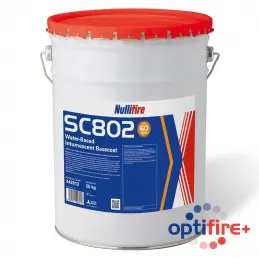
Nullifire SC802 On-Site Water-Based Intumescent Basecoat
A water-based, white, thin film intumescent coating for the protection of internal structural steelwork. Nullifire SC802 can provide up to 60 minutes fire resistance. Includes Optifire+ technology - reliable and traceable fire protectionPlease Note: We strongly recommend Tricomb Plastic Wet Film Gauges are used to help ensure correct...
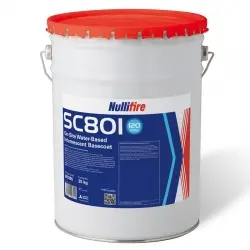
Nullifire SC801 On-Site Water-Based Intumescent Basecoat
Nullifire SC801 On-Site Water-Based Intumescent Basecoat is a water-based, white, thin film intumescent coating for the protection of internal structural steelwork, providing up to 120 minutes fire resistance. Please Note: We strongly recommend Tricomb Plastic Wet Film Gauges are used to help ensure correct film thicknesses are achieved...
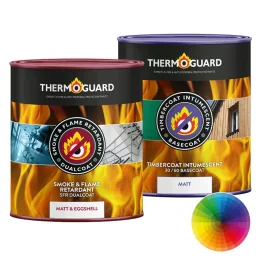
Thermoguard Timbercoat 60 Minute System
An intumescent paint system in 4,000+ colours for interior and exterior timber surfaces. Each pack contains the correct amount of basecoat (Timbercoat) and topcoat (Thermoguard Smoke & Flame Retardant (SFR) Dualcoat) to ensure protection is achieved inline with the manufacturers recommendations to the respective area in question....
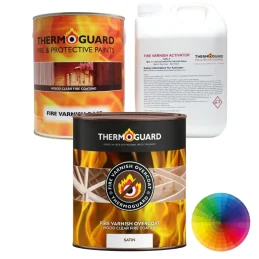
Thermoguard Fire Varnish BS Class 1/0 & EN Class B System
A clear fire retardant varnish for interior and exterior timber surfaces. Important!For use on timber with a minimum thickness of 9mm. Woodstains are only available on the following shipping options:Express: 1-3 Working Days Delivery (Thermoguard DS) Economy: 7-10 Working Days Nationwide DeliverySee further below for...
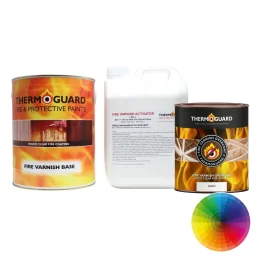
Thermoguard Fire Varnish 30 & 60 Minute System
A clear intumescent varnish (with 9 woodstain shades available) for interior and exterior timber surfaces. Each pack contains the correct amount of basecoat (Fire Varnish Basecoat) and topcoat (Thermoguard Fire Varnish Overcoat (Interior) or Thermoguard Fire Varnish Overcoat (Exterior)) to ensure protection is achieved inline with the...
Need Help?
Need Help?
Fire retardant paints are coatings applied to various materials, primarily wood and wood-based products, to enhance their fire performance. These paints are part of passive fire protection measures, which do not require activation to function effectively. Fire retardant paints improve the reaction to fire performance of the surfaces they cover, helping to prevent the spread of flames and reducing the heat released during a fire.
Fire retardant paints are crucial in improving the fire safety of buildings and structures by enhancing their resistance to fire and controlling the spread of flames. There are several types of fire-retardant paints, each designed for specific applications and materials. Here is an overview of the different types, their applications, and typical uses:
Types of Fire Retardant Paints
- Intumescent Coatings:
- Thin Film Intumescent Coatings: These are primarily used for structural steel and other metals. Upon exposure to heat, they swell to form an insulating char layer that protects the substrate from fire. Thin film coatings are typically used for up to one-hour fire resistance but can extend up to two hours for certain steel configurations.
- Thick Film Intumescent Coatings: These are epoxy-based and used in harsher environments like offshore and petrochemical industries. They provide a tougher protective layer, suitable for hydrocarbon fires and offering protection for up to four hours.
Ablative Coatings:
- These coatings generate gases or vapours that interfere with the flaming reactions, reducing the combustion rate. They are commonly used on various substrates, including wood and steel.
Surface Coatings:
- Water-Based and Solvent-Based Systems: Typically applied to steel and other metals, these coatings are designed to provide a decorative finish while also offering fire protection. They can be applied by spray, brush, or roller and are suitable for both internal and external environments.
Applications of Fire-Retardant Paints by Material
Wood and Wood-Based Materials
Fire retardant paints are widely used on wood and wood-based materials to improve their fire performance. These materials include:
- Hardwoods (e.g., birch, ash, oak)
- Softwoods (e.g., cedar, pine, larch)
- Man-Made Timbers
Fire retardant treatments for timber can be categorised into two primary groups:
Impregnation Treatments:
- Inorganic Salts Solutions or Leach-Resistant Chemicals: These involve vacuum and pressure processes to force fire retardant solutions deep into the timber. This method is particularly effective in enhancing the fire performance of hardwoods and certain softwoods. It ensures deep penetration and durability, making it less susceptible to abrasion compared to surface coatings. However, not all wood-based materials tolerate impregnation well; some may suffer from swelling.
Surface Coatings:
- Intumescent Coatings: These coatings swell upon exposure to heat, forming an insulating char layer that protects the substrate. They are suitable for both on-site and off-site applications and can be applied to various substrates, including existing painted surfaces (after compatibility checks). They are sensitive to moisture and temperatures, so care must be taken in humid conditions.
- Ablative Coatings: These coatings generate gases or vapours that interfere with the flaming reactions, reducing the combustion rate. They can be applied similarly to intumescent coatings.
Applications include upgrading fire doors and other wooden elements in buildings to improve their fire resistance while maintaining aesthetic features. For instance, flame retardant coatings are used to enhance the fire resistance of fire doors, considering the type of wood, door thickness, and other factors.
Steel Structures
Steel structures require specific fire protection measures due to their susceptibility to high temperatures. Fire retardant paints used on steel include:
Intumescent Paints:
- Thin Film Intumescent Coatings: These coatings are typically water-based or solvent-based and are applied in multiple coats to achieve the required thickness. They provide up to 1 hour of fire resistance, with some systems offering up to 2 hours for specific configurations.
- Thick Film Intumescent Coatings: Generally epoxy-based, these coatings are designed to withstand hydrocarbon fires and provide up to 4 hours of fire resistance. They are commonly used in the petrochemical industry but are increasingly applied in civil construction for their durability and tough finish.
Cementitious and Plaster-Based Coatings:
- These coatings, made from materials like vermiculite or perlite, gypsum, and man-made mineral fibres, provide a thick, insulating barrier against fire. They are applied by spray or trowel and can offer up to 4 hours of fire resistance. These systems are used both for internal and external environments.
Cladding Systems:
- Fire-resisting boards or stone wool products are used to encase steel structures, providing up to 4 hours of fire resistance. These systems are particularly effective for internal applications and some sheltered external uses.
Steel structures in buildings, such as office complexes and industrial facilities, often utilise these fire-retardant systems to prevent structural failure during fires, ensuring the building's stability and providing time for safe evacuation.
Other Materials
Fire retardant coatings are also applied to various other materials used in building construction, including:
- Concrete: Generally, concrete frames do not require additional fire protection due to their inherent fire resistance. However, in certain situations like road tunnels, additional fire protection may be necessary to prevent spalling.
- Composite Materials: These materials can also benefit from fire retardant coatings, especially in environments requiring high fire performance standards.
In all applications, the performance of fire-retardant paints depends on their correct application and the interaction with the substrate. Factors like surface preparation, environmental conditions during application, and adherence to manufacturer's guidelines are critical to achieving the desired fire resistance.
By using appropriate fire-retardant paints on various materials, buildings can significantly enhance their fire safety, ensuring compliance with fire safety regulations and protecting lives and property.
Typical Uses in Buildings and Structures
Commercial Buildings
Office Complexes and Retail Spaces Fire retardant paints in commercial buildings, such as office complexes and retail spaces, play a vital role in enhancing the safety of these environments. These paints are primarily used on structural steel frameworks, walls, and ceilings to maintain the structural integrity during a fire and prevent the spread of flames. Intumescent coatings, which swell up to form a char layer when exposed to high temperatures, are commonly used on steel structures. This application helps in prolonging the time for safe evacuation and allows firefighters to control the blaze before structural failure occurs.
Industrial Facilities
Factories and Warehouses In industrial settings like factories and warehouses, fire retardant coatings are essential due to the presence of flammable materials and machinery. These coatings are applied to structural steel, wood, and other materials to reduce the risk of fire spreading rapidly through the facility. Thick film intumescent coatings and ablative coatings are often used in these environments to provide a durable and effective fire barrier, especially in areas where there is a risk of high-temperature fires due to the industrial processes involved.
Petrochemical Complexes For petrochemical facilities, which deal with highly combustible liquids and gases, specialised thick film intumescent coatings are used. These coatings provide robust protection against hydrocarbon fires, which can reach extremely high temperatures quickly. The coatings form a protective char layer, insulating the structure from intense heat and preventing structural collapse.
Public Buildings
Schools, Hospitals, and Government Buildings In public buildings, fire safety is paramount due to the high occupancy and the need for quick evacuation routes. Fire retardant paints are used on walls, ceilings, and structural elements to enhance fire resistance and prevent flame spread. These coatings ensure that escape routes remain clear and structural integrity is maintained long enough for safe evacuation. Fire doors in these buildings are often treated with fire retardant coatings to enhance their resistance while maintaining their aesthetic appearance.
Residential Buildings
Multi-Storey Residential Buildings In multi-storey residential buildings, fire retardant paints are applied to steel frameworks, wooden elements, and interior surfaces to prevent the spread of fire between floors and compartments. This is crucial in maintaining safe evacuation routes and minimising the spread of fire. Surface coatings such as intumescent and ablative paints are used to protect timber and other materials, ensuring that they do not contribute to the growth of a fire.
FAQs
How Do Fire Retardant Paints Work?
Fire retardant paints prevent the spread of fire and reduce its intensity through various mechanisms:
- Intumescent Coatings: When exposed to heat, these coatings swell to form a thick, insulating char layer, expanding up to 50 times the original thickness. This layer protects the substrate from fire and is commonly used on structural steel.
- Ablative Coatings: These coatings generate gases that interfere with flaming reactions, reducing combustion and heat release. They are suitable for various substrates, including wood and steel.
- Cooling Effect: Some paints contain chemicals that undergo endothermic reactions, absorbing heat and cooling the surface to prevent ignition. This is used to protect materials like wood and certain plastics.
- Protective Layer Formation: Fire retardant paints can form a protective barrier over materials, preventing ignition by blocking heat and oxygen. This is common in intumescent paints on structural elements.
- Dilution of Radicals: These paints release water vapour or carbon dioxide when they burn, diluting radicals in the flame and reducing its intensity, useful for escape routes and public areas.
Testing and Performance Evaluation:
- Heat Release and Flame Spread: Fire retardant paints are tested for their ability to minimise heat release and prevent flame spread, with tests like BS 476 Part 6 and Part 7 in the UK. The effectiveness depends on both the paint and the substrate.
- Substrate Interaction: The fire performance is influenced by how the coating interacts with the substrate, including factors like wood type and surface condition.
What are Intumescent Coatings?
Intumescent coatings are a type of passive fire protection used to increase the fire resistance of structural elements and materials. These coatings are designed to swell significantly when exposed to high temperatures, forming a thick, insulating char layer that protects the substrate from the effects of fire.
Key Features and Mechanism of Intumescent Coatings
Swelling and Charring:
- When exposed to heat, intumescent coatings undergo a chemical reaction that causes them to expand many times their original thickness.
- This expansion forms a char layer that acts as an insulative barrier, reducing heat transfer to the underlying material.
Thermal Protection:
- The char layer effectively insulates the substrate from the high temperatures of the fire.
- This protection helps maintain the structural integrity of materials such as steel, preventing them from reaching temperatures that could lead to structural failure.
Multi-Layer Composition:
- Intumescent coatings are typically composed of several chemical components, including a binder, a carbon source, a blowing agent, and a catalyst.
- The binder holds the components together; the carbon source provides the material for the char; the blowing agent causes the expansion; and the catalyst accelerates the reaction.
What is the difference between intumescent and ablative coatings?
Intumescent Coatings:
- Mechanism: These coatings swell and form a char when exposed to high temperatures, creating an insulating barrier. At around 200°C, they react to form a thick char layer, up to 50 times the original thickness, offering thermal insulation.
- Durability: Thin film intumescent coatings provide up to 2-hours fire resistance on steel, while thick film versions can protect for up to four hours, especially in hydrocarbon fires.
- Applications: Commonly used on structural steel to maintain load-bearing capacity during a fire and can also be applied to wood.
Ablative Coatings:
- Mechanism: They release gases like water vapour or carbon dioxide during a fire, diluting flammable gases and cooling the flame. They alter the flame's chemical environment without forming a char.
- Applications: Often used on timber and wood-based materials where maintaining appearance is crucial, as well as on fabrics and certain plastics.
Comparison:
- Mechanism of Action:
- Intumescent: Swells to form a char layer.
- Ablative: Releases gases to interfere with flame chemistry.
- Performance:
- Intumescent: Provides thermal insulation, protecting structural elements.
- Ablative: Reduces combustion rate, preserving the material's appearance.
- Applications:
- Intumescent: Suited for structural protection like steel frameworks.
- Ablative: Used where maintaining surface appearance is important, such as in wood treatments.
Both are crucial in passive fire protection, chosen based on specific fire safety needs and material characteristics.
Can fire retardant paints be applied on existing painted surfaces?
Yes, fire retardant paints can be applied over existing painted surfaces (with the exception of surfaces previously painted with intumescent coatings), but careful preparation and adherence to guidelines are necessary. Always check with the manufacturer as not all intumescent paints can be applied over existing coatings.
Surface Preparation:
- Cleanliness: The surface must be free of dirt, grease, wax, and moisture to ensure proper adhesion.
- Condition of Existing Coating: Existing paint should be stable and well-adhered. Remove any peeling or flaking paint.
- Adhesion Tests: Apply a small area of fire-retardant paint as a test to ensure proper adhesion and curing.
Compatibility:
- Manufacturer’s Guidance: Consult with the paint manufacturer to ensure compatibility between the fire-retardant paint and existing coating.
- Primer Use: A primer may be needed to improve adhesion, depending on the types of paints involved.
Environmental Conditions:
- Application Conditions: Apply under suitable temperatures and humidity levels as specified by the manufacturer to ensure proper curing and performance.
Specific Considerations:
- Moisture Sensitivity: Some fire-retardant paints, like intumescent coatings, are sensitive to moisture, so choose a product designed for the specific environment.
- Thickness and Coverage: Apply the paint in correct thickness, possibly requiring multiple coats, with each coat properly dried and cured.
Practical Examples:
- Wall and Ceiling Linings: Can be coated, but performance depends on the substrate's original fire characteristics and proper surface preparation.
How is the performance of fire-retardant paints measured?
The performance of fire-retardant paints is rigorously measured through a combination of flame spread, heat release, ignitability, and fire resistance tests. These tests ensure that the paints provide effective fire protection and help prevent the spread of fire, thus enhancing the safety of buildings and their occupants. The results from these tests are classified according to national and international standards, providing a reliable benchmark for their performance in real-world fire scenarios.
1. Reaction to Fire
"Reaction to fire" refers to how a material responds when exposed to fire, specifically its propensity to ignite, spread flame, release heat, and produce smoke. This measurement is crucial for understanding how the material will behave in the initial stages of a fire.
- Ignitability: This measures how easily the material can catch fire.
- Flame Spread: This evaluates the rate and distance flames can travel across the material's surface.
- Heat Release: This determines the amount of heat emitted by the material during combustion.
- Smoke Production: This assesses the volume and toxicity of smoke generated by the burning material.
These properties are often evaluated using standardised tests such as the BS 476 series for the UK and EN 13501-1 for European classifications.
2. Flame Spread Tests
The flame spread test measures the lateral spread of flames over the surface of a material. This is crucial for assessing how quickly a fire can propagate across a surface.
- BS 476 Part 7 (UK): This test places a sample at right angles to a radiant heat source and measures the spread of flames. The results are classified into four categories, with Class 1 being the highest level of performance, indicating the least flame spread.
- EN ISO 11925-2 (Europe): This test involves direct flame impingement on the material and measures the ignitability and flame spread characteristics.
3. Heat Release Tests
Heat release tests measure the amount of heat emitted by the material during combustion. High heat release can contribute to fire growth and intensity.
- BS 476 Part 6 (UK): This test assesses fire propagation by measuring the heat released by a material when exposed to a specific heat source.
- EN 13823 (SBI Test - Europe): The Single Burning Item (SBI) test evaluates the heat release, smoke production, and flame spread of materials arranged in a corner configuration, simulating real-life conditions.
4. Non-Combustibility and Ignitability Tests
These tests determine whether a material can ignite and how it behaves when exposed to fire.
- EN ISO 1182: This test assesses the non-combustibility of building materials by exposing them to high temperatures and observing their reaction.
- EN ISO 11925-2: This small flame test measures the ignitability of materials when exposed to a small flame for a short duration.
5. Assessment of Fire Resistance
Fire resistance refers to the ability of a construction element to withstand fire and prevent its spread for a specified period. While fire retardant paints primarily enhance "reaction to fire" properties, they can also contribute to the overall fire resistance of a structure when combined with other fire protection measures.
- Load Bearing Capacity: This evaluates whether the structural elements can maintain their load bearing function during a fire.
- Integrity: This measures the ability of a material to prevent the passage of flames and hot gases through gaps and joints.
- Insulation: This assesses the material's ability to limit heat transfer to the unexposed side, preventing ignition of adjacent materials.
6. Standards and Classifications
In the UK, the performance of fire-retardant paints is classified according to BS 476 standards, while in Europe, the EN 13501-1 classification system is used. These standards ensure that the materials meet the necessary safety requirements and perform as expected in fire conditions.
What is a "Class 0" fire performance classification?
"Class 0" is a UK standard indicating the fire performance of materials used in building construction, particularly for wall and ceiling linings. It is achieved by meeting the following criteria in two British Standards tests:
- BS 476 Part 6 (Fire Propagation Test): Measures how much and how quickly a material contributes to fire growth. The material must have a fire propagation index (I) of no more than 12 and a sub-index (i1) of no more than 6.
- BS 476 Part 7 (Surface Spread of Flame Test): Assesses how flames spread along a material's surface. The material must achieve a Class 1 rating, indicating the least flame spread.
A "Class 0" rating means the material has very low contribution to fire growth and limited flame spread, making it suitable for critical areas like escape routes and public buildings. It is a UK-specific classification and may not directly compare with other international standards like the Euroclass system.
What is the difference between "reaction to fire" and "fire resistance"?
Reaction to Fire and Fire Resistance are two distinct but complementary fire safety concepts, both vital in protecting a building and its occupants during a fire.
- Reaction to Fire: Refers to how materials behave when exposed to fire, especially in the early stages. It measures properties like ignitability, flame spread, heat release, combustibility, and smoke production. Materials with good reaction to fire prevent rapid fire spread and are crucial for occupant safety and preventing flashover. This is classified using standards like the UK's Class 0 or the Euroclass system.
- Fire Resistance: Refers to the ability of a building element (walls, doors, floors) to withstand exposure to a fully developed fire for a specified period. It focuses on load-bearing capacity, integrity (preventing the passage of flames and smoke), and insulation (limiting temperature rise on the unexposed side). Fire resistance is measured in minutes or hours, indicating how long the element can maintain its function during a fire.
Can fire retardant paints improve the fire resistance of a structure?
Fire retardant paints enhance fire safety by improving a material's reaction to fire, reducing ignitability, flame spread, and heat release. However, their ability to improve fire resistance - the structural integrity of materials under fire conditions - is limited.
How They Work: Fire retardant paints slow down fire spread by forming a protective layer or releasing flame-inhibiting chemicals, particularly on wood. They do not significantly enhance a material's fire resistance unless specifically tested and certified for that purpose.
Limitations: To truly improve fire resistance, the entire structural system (material, paint, and application method) must be tested and certified. Applying fire retardant paint alone does not guarantee improved fire resistance without evidence from standardised testing.
In summary, while fire retardant paints help control flame spread, their role in improving structural fire resistance is limited and must be part of a broader fire protection strategy.
What are the application methods for fire retardant paints?
The application methods for fire retardant paints vary depending on the type of paint, the substrate it is applied to, and the environmental conditions.
Application Techniques:
- Brush Application:
- Suitable for small areas and detailed work.
- Ideal for intricate surfaces and touch-ups.
- Roller Application:
- Best for large, flat surfaces.
- Provides a smooth, even coat.
- May require multiple coats for desired protection.
- Spray Application:
- Suitable for large areas and complex structures.
- Offers uniform coverage and reaches difficult areas.
- Faster than brush or roller but requires proper equipment and safety measures.
Application Conditions:
- Apply within the manufacturer's specified temperature and humidity range for proper curing.
- Monitor surface and air temperatures to avoid extreme conditions.
- Ensure adequate ventilation, especially indoors.
Specific Considerations:
- Achieve the correct thickness, which may need multiple coats.
- Perform a trial application to check adhesion and curing.
- Factory-controlled applications can ensure consistent quality by pre-coating components.
What are the benefits of using thick film intumescent coatings?
Thick film intumescent coatings are known for their robustness and ability to provide long-lasting fire protection in severe environments. These benefits make thick film intumescent coatings an excellent choice for demanding applications where high levels of fire protection and durability are required:
- Enhanced Durability: Designed for harsh environments like offshore platforms and industrial settings, these coatings are more resistant to wear and environmental damage compared to thinner coatings.
- Higher Fire Resistance: Provide up to four hours of fire resistance, insulating the substrate and maintaining structural integrity during prolonged fire exposure.
- Application in Harsh Environments: Suitable for extreme temperatures, high humidity, and chemical exposure without compromising fire protection.
- Protection of Structural Steel: Prevent steel from reaching critical temperatures, maintaining the stability of structures during a fire.
- Long-Term Performance: Require less frequent maintenance, offering cost savings over the structure's lifespan.
- Compliance with Fire Safety Standards: Tested and certified to meet high safety standards, making them suitable for critical infrastructure. Thick film intumescent products should be applied be specialist, trained applicators only.
What testing standards are used for fire retardant paints in the UK?
In the UK, fire retardant paints must comply with both British standards (BS 476) and European standards (EN 13501-1, EN ISO 1182, EN ISO 1716, EN 13823, EN ISO 11925-2) to ensure they provide the necessary protection in case of a fire. These standards involve rigorous testing procedures to evaluate fire propagation, surface spread of flame, heat release, and ignitability, ensuring that materials used in construction meet the highest safety requirements.
BS 476 Series
BS 476 Part 6: Fire Propagation Test
- Purpose: Measures the contribution of a material to the growth of fire.
- Procedure: The test involves exposing a material to a controlled flame and measuring the heat release. The results are expressed as a fire propagation index, which indicates the material's ability to contribute to fire growth.
- Significance: A lower fire propagation index indicates better fire performance.
BS 476 Part 7: Surface Spread of Flame Test
- Purpose: Assesses the rate and extent of flame spread across the surface of a material.
- Procedure: A specimen is placed at right angles to a radiant heat source, and the spread of flame is measured over a specified period.
- Classification: Results are classified into four categories (Class 1 to Class 4), with Class 1 indicating the least flame spread.
- Significance: This test helps determine how quickly a fire can spread across the surface of building materials.
European Standards (EN)
EN 13501-1: Fire Classification of Construction Products and Building Elements
- Purpose: Provides the reaction to fire classification system for all construction products.
- Procedure: Involves several tests including non-combustibility, ignitability, heat release, and smoke production.
- Classification: Ranges from A1 (non-combustible) to F (no performance determined). This standard is crucial for harmonising fire safety across Europe.
- Significance: Ensures that products meet consistent fire safety requirements across different countries within Europe.
EN ISO 1182: Non-Combustibility Test
- Purpose: Determines the non-combustibility of building materials.
- Procedure: A sample is heated in a furnace, and temperature rise and duration of flaming are recorded.
- Classification: Used for materials seeking classification A1 and A2.
- Significance: Ensures that materials classified as non-combustible do not contribute to fire growth.
EN ISO 1716: Determination of the Heat of Combustion
- Purpose: Measures the potential heat release from a material when burned.
- Procedure: A powdered specimen is burned in a bomb calorimeter, and the heat of combustion is calculated.
- Significance: Helps in determining the overall fire load that a material can contribute to a fire.
EN 13823: Single Burning Item (SBI) Test
- Purpose: Measures lateral flame spread, heat release, smoke production, and flaming droplets/particles.
- Procedure: Test involves exposing a sample to a 30 kW flame in an intermediate scale open corner setup.
- Significance: Provides comprehensive data on how materials react to fire under realistic conditions.
EN ISO 11925-2: Ignitability Test
- Purpose: Determines the ignitability of building products when exposed to a small flame.
- Procedure: A flame is applied to the edge or surface of a vertically mounted test specimen, and the flame spread is measured.
- Significance: This test is crucial for classifying materials as B, C, D, E, or F based on their ignitability and flame spread.
Classification Systems
- Class 0 (UK Classification)
- Criteria: Achieved by meeting the requirements of BS 476 Part 6 and Part 7. It represents a high level of fire performance suitable for wall and ceiling linings.
- Importance: Ensures materials have limited contribution to fire growth and flame spread.
How do fire retardant paints contribute to passive fire protection?
Fire retardant paints contribute to passive fire protection by enhancing the fire resistance and fire performance of building materials and structures without the need for active systems like sprinklers or alarms. Passive fire protection is a critical aspect of building safety, designed to contain or slow the spread of fire, giving occupants more time to evacuate and reducing the overall damage to the structure.
- Enhancing Structural Fire Resistance: Intumescent coatings expand when exposed to heat, forming an insulating layer that delays the collapse of structural elements, allowing more time for evacuation and firefighting.
- Limiting Flame Spread and Heat Release: These paints slow down ignition and reduce heat release, helping contain fires and prevent them from spreading.
- Protecting Escape Routes: Applied to walls, ceilings, and fire doors, they ensure escape routes remain passable for longer during a fire.
- Compliance with Regulations: Fire retardant paints help buildings meet safety standards like BS 476 and EN 13501-1, ensuring legal compliance and safety.
- Preserving Fire Compartments: They help maintain the integrity of fire compartments, limiting fire and smoke spread within a building.
In summary, fire retardant paints are a key component of passive fire protection systems in buildings. They enhance the fire resistance of structural elements, limit flame spread, protect critical areas and escape routes, help meet regulatory requirements, and preserve the integrity of fire compartments, all of which contribute to a safer built environment.
Certificates
All of the intumescent paints we offer have been tested to varying British/European standards by recognised independent third parties depending on their required use and performance. In addition to these industry standard tests, some products also offer additional paperwork after use by way of a ‘certificate’ that can be obtained in different ways - manufacturer dependent. Some require a form to be completed and returned by email, others have online application forms, others can be simply called to provide project details verbally. Not ALL products offer this additional supplement and if this type of certificate is important to your project you should contact our Technical Team on 0113 2455450 (option 2) or [email protected] to advise them of this so they can ensure they recommend a suitable product accordingly. Certain larger projects may also require the involvement of an independent inspector, again you should contact our Technical Department to discuss this if required.
Our help and advice promise
Fire protection doesn’t have to be hard work, let our technical staff help you get the level of protection you require and the finish you want. Whether it’s structural steel in a warehouse, fire retardant paint for wood on a new-build, or the internal walls of a block of flats, we can provide a full specification and offer guidance throughout the project.
